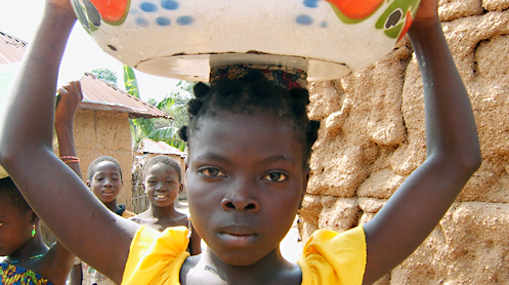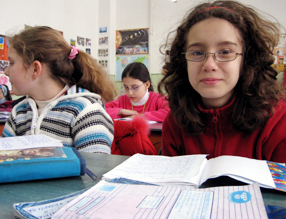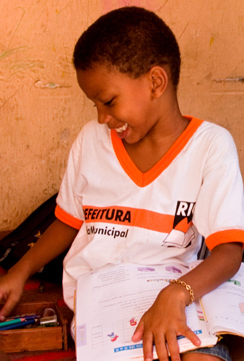By Gene B. Sperling
“What Works in Girls’ Education: Evidence and Policies from the Developing World”
One of the silent killers attacking the developing world is the lack of quality basic education for large numbers of the poorest children in the world’s poorest countries — particularly girls. Yet unlike many of the world’s most grievous ailments, this is a disease with a known cure. We know what tools are needed and what models are proven to work. We also know that the cost of that cure – perhaps $7.5 billion to $10 billion per year — is minuscule compared with the enormous benefits such education would bring for health, economics, women’s empowerment, and basic human dignity.
An estimated 110 million children — 60 percent of them girls — between the ages of six and 11 will not see the inside of a classroom this year. Another 150 million are likely to drop out before completing primary school.
More than half of all girls in sub-Saharan Africa do not complete primary school, and only 17 percent are enrolled in secondary school. Rates in rural areas are even worse. For instance, a 1996 study in Niger found that only 12 percent of girls in rural areas were enrolled in primary school, compared with 83 percent of girls in the capital.
The situation can be even worse for vulnerable children. In developing nations, those with disabilities and those affected by AIDS face even greater obstacles to education, while orphaned children are less likely to be enrolled in school than their peers who live with at least one parent. Only six percent of children in refugee camps are enrolled in secondary education, and opportunities for internally displaced children are even more limited.
Access is only part of the story. The other crucial factor is quality. As highlighted by “Education for All: The Quality Imperative,” the 2005 Global Monitoring Report by UNESCO, too many children leave school without mastering a basic set of skills. Ensuring a decent quality of education is an essential component of reform.
STRONG EVIDENCE
The good news is documented in “What Works in Girls’ Education,” a 2004 Council on Foreign Relations report that I co-authored with Barbara Herz, and is reinforced in a Mother’s Day 2005 report by Save the Children: we have extremely strong evidence both on the high returns on girls’ education and on what works to get girls in school. What is striking is the breadth of benefits derived from educating girls — not only economic benefits in terms of higher wages, greater agricultural productivity, and faster economic growth, but also health benefits, HIV prevention, and women’s empowerment.
Two 1999 World Bank studies found that closing the education gender gap in South Asia and sub-Saharan Africa would have led to faster economic growth between 1960 and 1992, while increasing the share of women with a secondary education can yield growth in per-capita income. Another 63-country study attributed 43 percent of the decline in malnutrition achieved between 1970 and 1995 to more productive farming as a result of increased female education.
Even more impressive are the gains to health that come from educating girls. An extra year of female education can reduce infant mortality by 5 percent to 10 percent. In Africa, children of mothers who receive five years of primary education are 40 percent less likely to die before age five than are children of uneducated mothers. Across both Africa and Southeast Asia, mothers who have a basic education are 50 percent more likely than uneducated mothers to immunize their children.
Education has also proven to be one of the most powerful tools to prevent the spread of HIV/AIDS. A recent study in rural Uganda found that, in comparison with young people with no education, those with some secondary education were three times less likely to be HIV-positive, and those with some primary schooling were about half as likely to be HIV-positive. In Kenya, a study of 17-year-old girls found that those in secondary school were almost four times as likely to be sexually inactive as those who had dropped out after primary school. In Swaziland, a 2003 study found that more than 70 percent of in-school youths were not sexually active, while nearly 70 percent of out-of-school youths were sexually active. And school-based AIDS education programs have been shown to reduce early sexual activity and high-risk behavior. According to the Global Campaign for Education, seven million cases of AIDS might be prevented over the next ten years if all children completed basic education.
WHAT WORKS
In making progress on girls’ education, there are three things to keep in mind.
First, while sending girls to school may be clearly beneficial both for the girls themselves and for their countries, in most poor nations it is the parents who make the ultimate choice on schooling, and for them this calculation may not seem so clear. Rightly or wrongly, such extremely impoverished parents often feel they need their girls’ labor for extra income or, more frequently, just to help with the grueling requirements of life, such as the long hours spent collecting water or firewood or caring for the younger children in the family.
The good news is, when you reduce the cost and increase the benefits of sending girls to school, most parents will choose a better future for their children. It is critical to develop and widely implement policies that work to align the temporary interests of parents with the longterm well-being of their girls and their societies. The simplest and most basic strategy to reduce costs for parents is to eliminate the per-child school fees that are still charged in many developing countries. We know this strategy works because countries that have reduced or eliminated school fees have seen enrollment skyrocket overnight. In Uganda, Kenya, and Tanzania, enrollment increased dramatically in the very first year after fees were abolished: from 3.4 million to 5.7 million students in Uganda in 1996; from 5.9 million to 7.2 million in Kenya in 2003; and from 1.5 million to 3 million in Tanzania in 2002.
Beyond eliminating fees, even modest additional incentives to parents have made a huge difference. Scholarships and conditional cash transfers have been shown to lift attendance of both girls and boys in countries such as Bangladesh, Mexico, and Brazil. School-based health and nutrition programs have also proven successful. In Kenya, for instance, school meals were found to raise attendance by 30 percent and to boost test scores.
Reducing the distance children must travel to school is also critical because it both cuts down on the time children must spend away from home and alleviates parental concerns for the safety of their children, especially their girls, as they walk to and from school. Policies that both build parental trust and make schools more girl-friendly — such as hiring more female teachers, forming parental committees, and providing latrine facilities for girls — have all been shown to increase girls’ enrollment.
Second, while it is crucial that countries make an extra effort and institute special initiatives to target girls’ education, these endeavors will work only in the context of a broader focus on universal basic education for all children. Though the educational gaps for girls are especially large, the problems for boys — particularly poor, rural boys — are also dramatic. Furthermore, efforts to get girls into schools will never be successful unless there is a decent quality of education — respectable class sizes, trained teachers, quality instructional materials — for both girls and boys.
Third, while the impetus for all major education reforms must come from the local and national levels of countries themselves, it is critical that there be a global compact that pairs a commitment from developing countries to institute necessary reforms with a clear contingent commitment from donors to provide resources to countries that fulfill their part of the compact. This is especially critical because the major cost for poor countries seeking universal basic education is the recurring cost of teachers’ salaries.
The key to such a compact is certainty. Donors must feel certain that there is a commitment to good governance, careful monitoring, and national ownership of any plan to expand basic education. Leaders of developing countries, on the other hand, must have the certainty that, if they are willing to take on the enormous task of mobilizing political will and resources to seek universal basic education, then donors will live up to their part of the compact by providing the substantial funds needed to fill their financing gap.
This was the promise of the Dakar meeting hosted by UNESCO in 2000, where more than 180 nations — including the United States — committed to the simple yet profound goal (which later became a Millennium Development Goal) of achieving universal basic education by 2015. The global compact on education that emerged from Dakar required developing countries to demonstrate a real commitment to the goal of universal basic education by developing their own national education plans — based on political will, domestic resource mobilization, and accountability — while rich countries pledged that “no country seriously committed to Education for All will be thwarted in its achievement of universal primary school completion by 2015 due to lack of resources.”
Instilling confidence that donors will live up to their pledge is particularly important in light of the multiple crises facing most poor countries and the reality that many of the economic benefits of achieving universal basic education will not be realized until after current leaders have left office. When the leaders of a poor nation consider taking on such a challenge even though the political payoff may flow to their successors, it is essential that the global community at least make it clear that those leaders will not be left without the resources to succeed.
In the five years since Dakar, there has been some progress on these promises. The world established the Fast Track Initiative (FTI), a new global financing mechanism designed to direct coordinated funding to low-income countries that have developed quality national education plans. As of July 2005, 16 countries had been endorsed by FTI, and an estimated 44 others could be ready over the next two years.
FTI represents an important step toward a certain and viable global compact on education. Unfortunately, donors’ contributions have to date been far short of what is required. As the World Economic Forum’s Global Governance Initiative reported, donors in 2004 delivered less than 10 percent of what is needed annually to achieve universal primary education.18 The global community will ultimately need to provide another $7.5 billion to $10 billion annually, above the pathetic $2 billion that is now provided in external assistance for basic education.
While reform must always emanate from the local communities and national governments of poor nations, it would be inexcusable if educational and political leaders in developing nations were discouraged from taking bold steps to provide all of their children a free and quality basic education simply because they lacked confidence that donor nations would hold up their end of the global bargain.
Gene B. Sperling is senior fellow for economic policy and director of the Center for Universal Education at the Council on Foreign Relations in Washington, D.C. He served as President Clinton’s national economic advisor and head of the National Economic Council from 1997 to 2001.
Footnotes
1 Education for All Global Monitoring Report 2003/4: Education for All: The Leap to Equality (Paris: UNESCO, 2003).
2 Niger Poverty Assessment: A Resilient People in a Harsh Environment (Washington, D.C.: World Bank, 1996).
3 Global Survey on Education in Emergencies (New York: Women’s Commission for Refugee Women and Children, 2004), p. iii.
4 Education for All Global Monitoring Report 2005: Education for All: The Quality Imperative (Paris: UNESCO, 2004).
5 Gene Sperling and Barbara Herz, What Works in Girls’ Education: Evidence and Policies from the Developing World (Washington, D.C.: Council on Foreign Relations, 2004); and State of the World’s Mothers 2005: The Power and Promise of Girls’ Education (Westport, Conn.: Save the Children, 2005).
6 Stephan Klasen, “Does Gender Inequality Reduce Growth and Development? Evidence from Cross-Country Regressions,” Policy Research Report on Gender and Development, Working Paper No. 7, World Bank, Washington, D.C., 1999; and David Dollar and Roberta Gatti, “Gender Inequality, Income, and Growth: Are Good Times Good for Women?,” Policy Research Report on Gender and Development, Working Paper No. 1, World Bank, Washington, D.C., 1999.
7 Lisa C. Smith and Lawrence Haddad, “Explaining Child Malnutrition in Developing Countries: A Cross-Country Analysis,” Discussion Paper 60, IFPRI Food Consumption and Nutrition Division, Washington, D.C., 1999.
8 Paul T. Schultz, “Returns to Women’s Schooling,” in Elizabeth King and M. Anne Hill, eds., Women’s Education in Developing Countries: Barriers, Benefits, and Policy (Baltimore: Johns Hopkins University Press, 1993).
9 Lawrence H. Summers, Investing in All the People: Educating Women in Developing Countries (Washington, D.C.: World Bank, 1994).
10 Anastasia Gage, Elisabeth Sommerfelt, and Andrea Piani, “Household Structure and Childhood Immunization in Niger and Nigeria,” Demography, vol. 34, 1997, pp. 295-309.
11 Damien De Walque, “How Does Educational Attainment Affect the Risk of Being Infected with HIV/AIDS? Evidence from a General Population Cohort in Rural Uganda,” World Bank Development Group Working Paper, Washington, D.C., 2004.
12 Education and HIV Prevention (New York: UNICEF, 2002), citing data from Kenya Demographic and Health Survey.
13 Alan Whiteside et al., What Is Driving the HIV/AIDS Epidemic in Swaziland? (Durban, South Africa:Health Economics and HIV/AIDS Research Division, University of Natal, 2003).
14 Douglas Kirby et al., “School-Based Programs to Reduce Risk Behaviors: A Review of Effectiveness,” Public Health Reports, vol. 109, 1994, pp. 339-61.
15 Christel Vermeersch, “School Means, Educational Achievement, and School Competition: Evidence from a Randomized Experiment,” unpublished paper, Harvard University, Cambridge, Mass., 2002.
16 For further discussion of such a global compact on education, see Gene Sperling, “Toward Universal Education: Making a Promise, and Keeping It,” Foreign Affairs, September/October 2001, pp. 7-13; idem, “Toward a Global Compact on Universal Education,” testimony before the Foreign Operations Subcommittee of the U.S. House of Representatives Committee on Appropriations, 14 May 2003; and Gene Sperling and Rekha Balu, “Designing a Global Compact on Education,” Finance & Development, June 2005, pp. 38-41.
17 The Dakar Framework for Action (Paris: UNESCO, 2000), p. 9. 18. Global Governance Initiative Annual Report 2005 (Geneva: World Economic Forum, 2005).
Top photo: Nanavi w pot on head. Credit: Hervé Cohen



